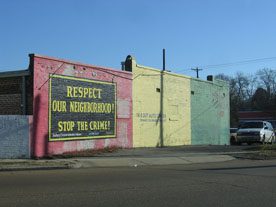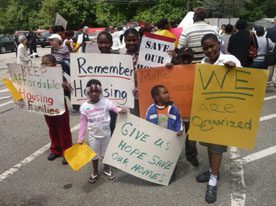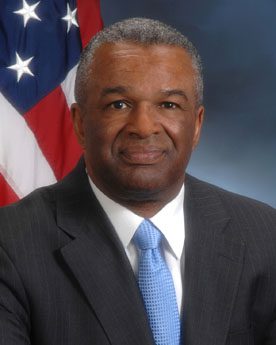
In the post-WWII era, large numbers of families moved out of the older, modest homes built on small lots in the residential districts surrounding downtown to occupy newer, larger homes constructed on more spacious suburban lots. Residents making the move to the suburbs were motivated by the desire to enjoy a more rural lifestyle, improve their housing, and reduce their property taxes. Aided by federal housing policies and encouraged by the mortgage banking and insurance industry practices, they also moved to distance themselves from the city’s changing demographics.
As the pace of suburbanization quickened in the 1960s and 1970s, fueled in part by the 1954 Brown v. Board of Education Supreme Court decision, the city pursued an aggressive policy of land annexation. While this strategy served to maintain the city’s overall population, it did so by incorporating low-density development at the city’s periphery. The investment required to service these new greenfield areas took place at the expense of the city’s older residential communities, resulting in building and property disinvestment and abandonment in these neighborhoods.
As signs of “blight” became increasingly visible within the city’s once thriving downtown, Memphis, like many other cities, began using federal highway, public housing, and urban renewal funds in an attempt to stabilize its downtown and nearby residential neighborhoods. Between 1959 and 1975, the city used federal Urban Renewal funds to clear more than 560 acres of land, displacing large numbers of African-American residents and businesses. While only 18 acres of the cleared land remained vacant by the early 1990s, the land uses within the city’s urban renewal areas had changed dramatically. Low-income housing, neighborhood-oriented retail, and local community and religious centers were replaced with high-end market-rate housing, large-scale commercial centers, and major civic and cultural venues, including a new City Hall complex and convention center.
The city was fundamentally changed by the assassination of Dr. Martin Luther King Jr., who had come to Memphis to support the struggle of local sanitation workers seeking union recognition and improved working conditions. Following Dr. King’s death in 1968, many long-time Memphians, fearing violence, moved their homes, businesses, and churches from the city to suburban communities to the east. By the 1980s, Memphis had become one of the poorest cities in the nation, suffering from high dropout, unemployment, poverty, and crime rates. Efforts to overcome these economic problems in the 1980s and 1990s were greatly complicated by the local municipal government’s reputation for ineptitude and corruption and the federal government’s cuts in domestic social programs, unfunded mandates, and devolution policies.
In the early 1990s, a new generation of civic leaders came of age within the city’s development, medical, higher education, architecture, and nonprofit sectors. With the support of Memphis’s influential corporate sector and the local philanthropic community, five important developments took place that signaled renewed hope for the city’s long-struggling downtown and older residential neighborhoods.
First, a group of visionary developers and architects transformed many of the downtown’s historic structures and vacant lots into attractive new residential spaces, inspired by New Urbanist ideals. These developments attracted approximately 25,000 new residents to the downtown.
Second, the city effectively used HOPE VI funds to transform four of its most severely deteriorated public housing projects into attractive and desirable mixed-use developments, offering former and current low-income residents improved housing along with an integrated suite of case management services.
Third, the leaders of the city’s major hospitals and health research centers came together to establish the Biomedical Research Center. During the past five years, the city’s hospitals and medical research centers have added more than 2.5 million square feet of new space within a crescent area surrounding the downtown.
Fourth, under the leadership of a new president, the University of Memphis adopted Ernest Boyer’s concept of “scholarship of engagement,” encouraging its students and faculty to connect their research activities to the ongoing community development efforts of local citizen organizations and municipal agencies.
Finally, the Community Development Council of Greater Memphis, a network of approximately 25 community-based development organizations, undertook an ambitious set of residential and commercial revitalization efforts that have successfully restored one neighborhood, stabilized several others, and reduced the impact of the recent home mortgage foreclosure crisis in many other areas of the city.
Community Development Challenges in Memphis
The election of President Barack Obama, who is highly supportive of resident-led revitalization efforts, along with the recent election of Memphis Mayor A. C. Wharton, presents the city’s community development community with exciting new opportunities. However, in order to take full advantage of them, these organizations will have to address a number of critical strategic challenges. While these challenges may be particularly acute in Memphis, where persistent urban poverty is so pervasive, these same issues confront community development corporations (CDCs) in many other cities suffering from weak regional economies and real estate markets.
Mergers and Acquisitions. The overwhelming majority of the housing renovations, new home construction, loan counseling, commercial lending, and educational and social service programs undertaken by community development corporations within the region are completed by a handful of the largest organizations that have significant capacity. Yet, these organizations are forced to compete for the limited resources available against a large number of small CDCs that have never developed a high level of staff expertise, effective boards of directors, or a track record of producing significant services and projects. Area funders bombarded by annual requests for support are increasingly challenging local CDCs to pursue mergers to create a smaller number of higher capacity community-based development organizations.
Sector Restructuring. Currently, most CDCs attempt to be all things for their local constituencies. There is currently very little functional specialization within the sector. As a result, most CDCs never get enough experience with a particular aspect of community development to become highly skilled and effective. Drawing upon the Central Place Theory of the German geographer Walter Christaller, CDC leaders might conceive of their sector as a nested hierarchy. At the base of this structure would be neighborhood areas or housing projects of 5,000�7,000 that would have their own voluntary citizen organizations to gather residents’ redevelopment ideas, coordinate self-help improvement projects, and put pressure on local officials to preserve the unique character of their neighborhoods. These groups would not, however, attempt to function as production-oriented community development corporations. The next level of the hierarchy would feature districts of 50,000 to 75,000 persons that would have their own full-service CDCs to design and implement a full array of housing rehabilitation and construction, loan counseling, job training, crime prevention, and youth development activities.
At the citywide level there would be a single trade association through which senior CDC staff would receive advanced management training and professional recruitment assistance and participate in issue advocacy. At the regional level, there would be a single organization to undertake larger economic development projects and workforce development programs. Finally, there would be one financial intermediary at the regional level to assist local CDCs, the regionwide organizations described above, and local government agencies in accessing state and federal development funds as well as local, national, and international socially responsible investor funds.
A Local Intermediary. Recently, Seedco, a national intermediary with headquarters in New York City, opened a Memphis office; however, due to modest funding, it is currently operating at a scale that limits its ability to address the region’s community development training, finance, organizational development, and technical assistance needs. The absence of a full-service national intermediary has hampered the growth and development of the region’s community-based planning and development sector. There is a growing awareness within the CDC community, local government, and area foundations that such an intermediary is needed and that either the existing organization should be assisted in growing into this role or another organization should be recruited to fill this gap.
State-Level Community Development Finance Tools
Tennessee-based community development corporations have few state-supported community development finance tools to support their work. Unlike their colleagues in New Jersey, local CDC directors cannot take advantage of a community development tax credit program to raise capital for large-scale comprehensive community revitalization initiatives. Unlike their Rhode Island counterparts, local CDC directors cannot use a state-supported historic preservation tax credit program to supplement those incentives provided by the federal government. As a result, local CDCs are able to initiate fewer projects in neighborhoods where market conditions are weak. Local residents, businesses, CDCs, and municipal governments affected by this lack of tools represent a potential coalition to press for new funding programs as the regional and national economy begins to recover.
Direct Action Organizing. While the CDCs in the region struggle with limited resources to stem the tide of foreclosure and abandonment in poor and working-class communities, the city of Memphis and Shelby County continue to commit significant resources to projects that will, in all likelihood, further exacerbate the increasingly uneven pattern of development taking place within the region.
For example, the city of Memphis and Shelby County are currently pursuing the development of the Mid-South Fairgrounds, 165 acres of publicly owned land in the heart of the city. Residents of the Beltline and Orange Mound neighborhoods, two lower-income African-American communities adjacent to this site, are likely to experience significant harm as a result of the various developments proposed for this site. However, their efforts to secure a community benefits agreement to address these concerns have been resisted by local officials.
Another example of questionable policy-making is the encouragement local officials have given to the construction of a new light rail line that would connect the airport and downtown as part of the proposed Memphis Aerotropolis initiative. In a city where a considerable portion of the resident population is mass transit dependent and often poorly served by the current public transit system, the massive investment needed for an airport to downtown service appears hard to justify, especially in light of local transportation officials’ failure to give serious consideration to a cheaper bus rapid transit system.
Finally, there has been little public discussion of or opposition to plans by Tennessee and U.S. transportation officials to build what is, in essence, a third ring road (I-269) approximately thirty miles from the city center, which will further reinforce the current trend toward unplanned, low-density development at the urban periphery. This project, if built, will further undermine the vitality of many older residential neighborhoods, where the majority of Memphis’s CDCs have focused their revitalization efforts.
There appear to be at least two reasons for the absence of an organized CDC voice on these important municipal and regional development issues. First, the requirements of successful urban development in a recessionary market can easily consume all of a CDC’s resources. Second, many of the region’s CDCs are dependent on the city and county for a large portion of their development funds and, thus, may be unwilling to challenge the development priorities and commitments of these local governments. Acknowledging the serious obstacles that exist to direct CDC involvement in local policy-making raises the question as to whether or not these organizations could support either the direct organizing of low-income and working-class residents by organizations such as ACORN or Citizen Action or the indirect organizing of local residents through their religious congregations by organizations such as the Industrial Areas Foundation or the Gamaliel Foundation.
Lifting the Blues
For the first time in 17 years, Memphians have elected a new mayor. A.C. Wharton has demonstrated a strong commitment to urban neighborhoods and participatory policy-making during his career. This, along with the new economic and community development funding being made available by the Obama administration, provides a new opportunity for local CDCs to move from the margins of the urban development process to a new leadership position within the city and region. To do so will require them to, in the words of Tanzania’s founding president, Julius Nyerere, “run while others walk.”
In the Memphis context, this will require serious consideration of consolidation to achieve greater program efficiency through economies of scale, as well as the reorganization of the CDC sector to promote improved program effectiveness through specialization. It will also demand greater presence of a national intermediary to enhance regional access to national and international investment funds and the initiation of an aggressive state legislative program to expand the range of financing tools available to local CDCs. Finally, it will necessitate support for grassroots organizing to challenge the current development policies of local government, which undermine the revitalization work of local CDCs.
Can the Memphis CDC community successfully undertake these organizational development, advocacy, and community organizing activities while maintaining their current level of economic and community development work? Anyone who has watched the leaders of this sector guide their organizations through the extremely challenging urban policies of the Bush administration era would be confident that they can do so. But as Ringo Starr of the Beatles wrote and sang, “You know it don’t come easy!”




Comments